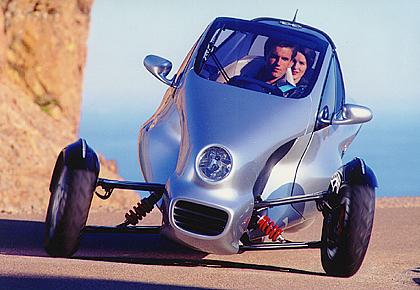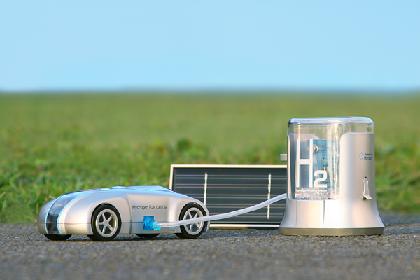











Pierre Ethier, a mechanical engineer with a Master Degree in motorcycle dynamics from Laval University, Quebec, who has designed novel, two-wheel and three-wheel concept vehicles for over 30 years, tells me that three-wheelers with two front, driving / steering wheels resolve the rollover problem.
With the weight of the engine in front of the two front wheels and the weight of the passenger(s) sitting behind the front wheels, the center of gravity of the occupied vehicle is close to the two front wheels, thus providing stability against rollover. (Another designer suggests a 4:1 weight distribution for tilting three wheelers.) Such a configuration is more like a normal, four-wheeled car. Pierre Ethier asserts that this type of three wheel configuration can be as stable as any car on the road and, in normal use, cannot be rolled over in curves.
Unfortunately, from my perspective it adds to the expense of the vehicle since it would:
- Require two Wavecrest drive units instead of one
- Demand a more sophisticated front steering / suspension system
- Limit more the use of the rear of the vehicle.
On this three-wheel NEV only the single rear wheel would have a standard disc brake, since braking for the two front wheels would be provided by the Wavecrest propulsion drive system and integrated propulsion control system. And, to reduce the cost further I dropped the idea of using low weight, solid, concentric cylinder, carbon fiber composite, energy-conserving wheels.

A short loop around the test track…
It is comforting to learn that someone else already designed this vehicle, albeit less comforting to know that the company stopped production. The 1999 NEVCO Gizmo was an eight foot long, single person, three-wheeled, electric commuter capable of highway speeds. It looked somewhat like the Mercedes Lifejet except James Bond had switched from the spy business to pizza delivery. Some of the things that I liked about the design:
- Two front drive / steering wheels
- Not a tilting design
- Batteries: sealed, lead acid
- Chassis: steel tube truss. The points for front trailing axle and rear swing arm pivot are located on the chassis.
- The trailing arm front axle allows suspension travel while eliminating side roll (a problem typical of three wheeled vehicles with independent suspension).
- The rear wheel is supported by a motorcycle type mono shock swing arm.
- The rear wheel is supported by a motorcycle type mono shock swing arm.
- Brakes: hydraulic disc
- Recharge power source: standard 110V AC outlet
- The front opening, canopy provides access to the vehicle, particularly for people with mobility limitations. It serves a multifunction role as a bumper structure, footrest, instrument panel, windshield and fairing.
The
idea behind the F 300 Life Jet, presented at the Frankfurt Motor
Show, was to combine the benefits of a motorcycle with those of a car. Cool photos.
Being able to lean into corners, to feel the power of the engine, and
be closer to the elements: these are the trademark motorbike
characteristics of the F 300 Life Jet. Its car-like properties include
greater stability thanks to its three wheels, a roof, seat belts and
air conditioning. In addition, it requires neither a helmet nor
protective clothing.
idea behind the F 300 Life Jet, presented at the Frankfurt Motor
Show, was to combine the benefits of a motorcycle with those of a car. Cool photos.
Being able to lean into corners, to feel the power of the engine, and
be closer to the elements: these are the trademark motorbike
characteristics of the F 300 Life Jet. Its car-like properties include
greater stability thanks to its three wheels, a roof, seat belts and
air conditioning. In addition, it requires neither a helmet nor
protective clothing.
The most striking feature of this
research vehicle was its unique Active Tilt Control, which was
developed specially for the F 300 Life Jet and allows it lean into
corners. It also featured specially developed tyres that allowed for
such a large tilt angle. The chassis of the F 300 Life Jet was made of
aluminium and weighed just 89 kilograms. The bodyshell was inspired by
aeroplane design, as were the vertically opening front-hinged doors. In
fine weather, the two roof sections could be removed and stowed in the
boot, turning the F 300 Life Jet into a cabriolet.
research vehicle was its unique Active Tilt Control, which was
developed specially for the F 300 Life Jet and allows it lean into
corners. It also featured specially developed tyres that allowed for
such a large tilt angle. The chassis of the F 300 Life Jet was made of
aluminium and weighed just 89 kilograms. The bodyshell was inspired by
aeroplane design, as were the vertically opening front-hinged doors. In
fine weather, the two roof sections could be removed and stowed in the
boot, turning the F 300 Life Jet into a cabriolet.
The
headlamps’ electronics were linked to the computer for the Active Tilt
Control system and could thus switch on a special cornering light. The
idea of headlamps that follow the line of the road can now be found in
the Active Light System available on Mercedes-Benz cars such as the
E-Class.
Control system and could thus switch on a special cornering light. The
idea of headlamps that follow the line of the road can now be found in
the Active Light System available on Mercedes-Benz cars such as the
E-Class.
The F 300 Life Jet was the first research vehicle to
be designed completed by computer. As such, it also served to test a
new design tool.
be designed completed by computer. As such, it also served to test a
new design tool.





























